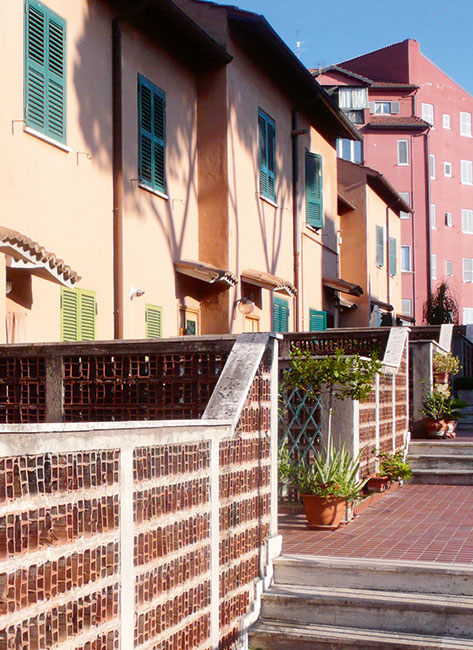INA - Casa Tiburtino Rome
Mario Ridolfi & Ludovico Quaroni
Samenvatting
Tussen het grid met woonblokken in de periferie van Rome, ligt langs de Via Tiburtina een wijkje dat opvalt door een volstrekt andere opzet. Linten aaneengesloten huizenblokken van drie tot vijf lagen hoog in aardse kleuren geel, oranje, rood en roze vormen omsloten, informele stedelijke ruimten, waarin groen en parkeren losjes zijn opgenomen. Driehoekige woontorens van zeven lagen accentueren de entrees, terwijl lage zeskantige gebouwtjes in de binnengebieden voorzieningen als winkels en een restaurant herbergen. Geen straat of gezichtspunt is gelijk en ondanks de stedelijke hoogte heerst er een bijna dorpse sfeer.
Om de oorsprong van deze wijk te begrijpen, moeten we terug naar de jaren vlak na de Tweede Wereldoorlog, toen Italië zich net als veel andere Europese landen geconfronteerd zag met een wederopbouwvraag en architecten op zoek gingen naar andere bouwwijzen dan de razionalismo, Italiaans uitvloeisel van de moderne beweging, die met zijn abstracte, neoclassicistische monumentaliteit met het fascisme werd verbonden. De gewone man zou hierdoor vervreemd zijn van zijn woonomgeving; door vormen, technieken en materialen uit het verleden op eigentijdse manier terug te brengen, kon volgens de ‘neorealisten’ weer een relatie worden gelegd met diens belevingswereld. Een woningbouwinitiatief van het Istituto Nazionale delle Assicurazioni, INA-Casa, had als tweeledig doel goedkope arbeiderswoningen en maximale werkgelegenheid te creëren. Onder de vlag van dit programma ontwierpen Ludovico Quaroni en Mario Ridolfi samen met 11 toen nog zeer jonge architecten de wijk, die nu geldt als de representant van het neorealisme.
Quaroni beriep zich voor het stedenbouwkundig plan op Scandinavische voorbeelden, die hij een ‘Italiaans accent’ meegaf. Ridolfi, zoon van een ambachtsman, was tijdens de oorlog coördinator geweest van de Manuale d’Architetto, een handboek vol uitvoeringsdetails, dat de basis legde voor het INA-Casa programma. Samen met zijn vaste medewerker Wolfgang Frankl (een oudleerling van Paul Schmitthenner) greep hij deze gelegenheid aan om zijn kennis van ambachtelijke uitvoeringstechniek te combineren met ideeën over standaardisering van bouwelementen, zodat op economische wijze toch zoveel mogelijk verschillen konden ontstaan.
Ridolfi ontwierp de vier driezijdige torens, diverse woonblokken en de winkels. In de vorm van de bebouwing zijn referenties naar Italiaanse landelijke bouwstijlen terug te vinden, terwijl in de materialisering eenvoudige uitvoering en recente bouwtechniek gepaard gaan. Zo is het hier getekende schijfje van drie lagen met een opgetilde straat op de eerste verdieping een herinterpretatie van oude vissershuizen op het eilandje Ponza, hier uitgevoerd in een combinatie van gestucte tufsteen, gestandaardiseerde deuren, ramen en luiken, en gewapend beton voor de trappen en balkons. De onderste woningen worden ontsloten via een kleine patio op straatniveau; die daarboven vanaf de opgetilde straat.



